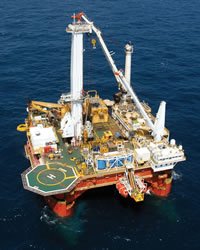A significant new source of natural gas, methane, has been found locked up in crystalline form in the Gulf of Mexico. Capturing methane from these so-called methane hydrates could stave off gas shortages predicted by many observers.
A consortium of US government agencies, university researchers, and petrochemical companies, including Chevron, confirmed that the Gulf of Mexico is the first offshore area of the US with methane hydrates at viable levels for commercial gas production.

Methane hydrates, as the name suggests, are composed of gas and water, and are known to exist widely in nature. Indeed, the discovery of vast, but inaccessible, reservoirs of methane hydrates in some parts of the world often beneath permafrost have led to concerns that as the climate heats up, the carbon-containing gas would be inadvertently released into the atmosphere. It would act as a potent greenhouse gas accelerating global warming still further.
However, accessible supplies of methane hydrates might also provide an alternative supply of natural gas for fuel, heating, and cooking needs in the face of falling oil supplies. Of course, the use of this resource would not reduce our reliance on fossil fuels nor necessarily motivate the development of sustainable energy sources.

This is an exciting discovery because we were able to predict hydrate accumulations before drilling, and we discovered thick, methane hydrate-saturated sands that actually represent energy targets, explains Brenda Pierce coordinator of the US Geological Survey Energy Program.
The methane hydrates are present not only in sand reservoirs, but in thick layers among the fractures in shales. In the case of the Walker Ridge and Green Canyon drill sites gas-hydrate-bearing sand reservoirs between 15 and 30 metres thick were discovered.
USGS Scientist Timothy Collett explains that, These sites should provide a wealth of opportunities for further study and data collection that should provide significant advances in understanding the nature and development of methane hydrate systems.
The discovery of concentrated methane hydrates in sand reservoirs has made Walker Ridge and Green Canyon prime locations for future research drilling, coring, and production testing.
Further reading
Energy Research and News
http://energy.usgs.gov/
Suggested searches
fossil fuels
methane hydrate